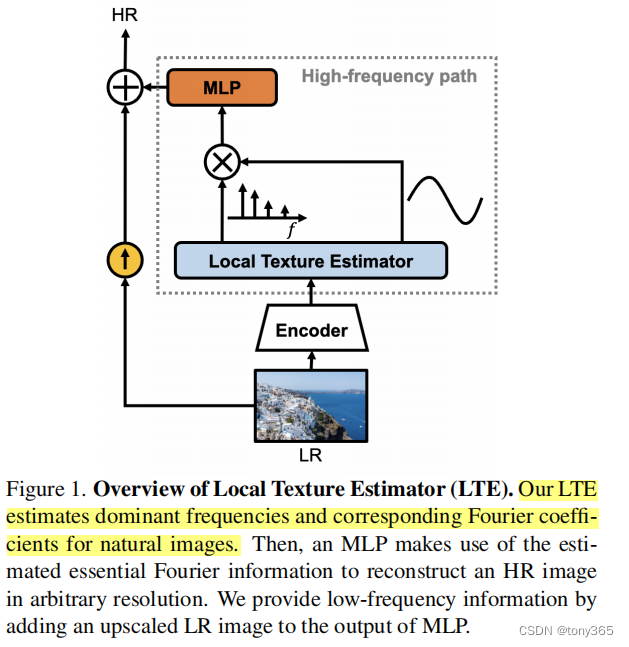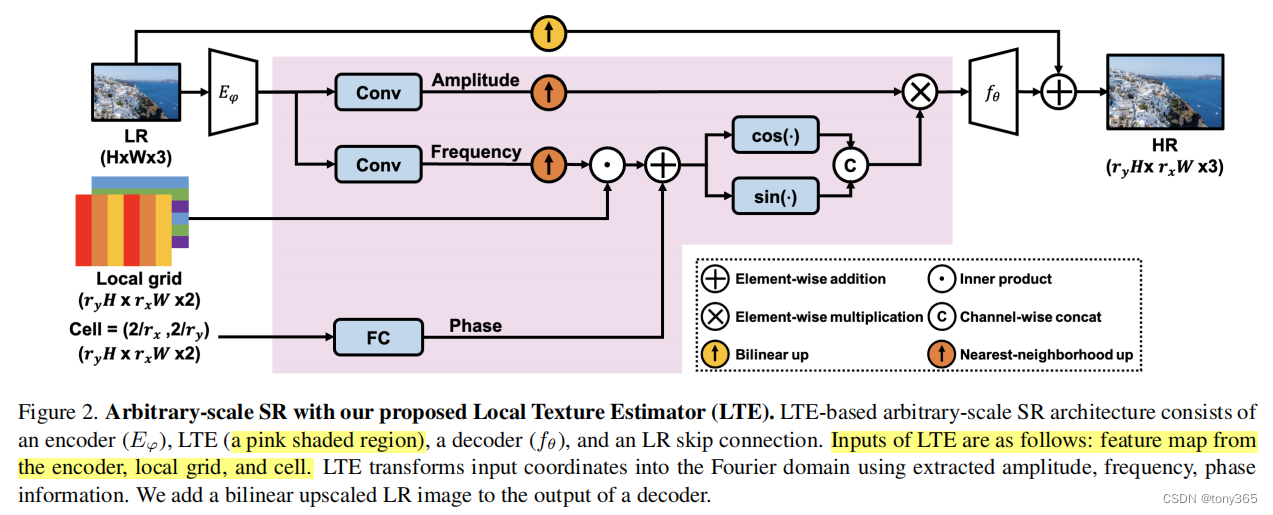文章目录
1. Local Texture Estimator for Implicit Representation Function
1. 通过隐式神经网络表示方法 实现 超分辨率。
一个典型的隐式表示方法作超分:


z
z
z 是encoder的输出,可以理解为提取的图像特征
x
x
x 是输入的坐标点映射到LR图像中,浮点类型,
x
j
x_j
xj 是周围的4个点
f
θ
f_\theta
fθ 是解码器,本文解码器是一个MLP
可以理解为,输入一个坐标,利用 1)最近的4个点的特征
z
j
z_j
zj 和 2)与最近4个点的 距离
x
−
x
j
x-x_j
x−xj
得到解码后的值,进行双线性插值。如下图所示

2. 在编码器和解码器之间作者引入一个 local texture estimator
因此公式变为

h
φ
h_\varphi
hφ 表示局部纹理估计,下图红色区域看起来复杂
其实就是下面的公式 其中 $ F, A, h_p©$ 分别表示 幅度,频率,相位
其中相位的输入是网格的长度 cell size


3. 代码分析
整体框架
def forward(self, inp, coord, cell):
self.gen_feat(inp) # 生成特征
return self.query_rgb(coord, cell) # 检索值
生成图像特征,编码器是一个常规的卷积网络,文中使用esdr,rdn, swinIR 等
feat 各通过一个卷积得到 coeff, freqq ,即幅度和频率
def gen_feat(self, inp):
self.inp = inp
self.feat_coord = make_coord(inp.shape[-2:], flatten=False).cuda() \
.permute(2, 0, 1) \
.unsqueeze(0).expand(inp.shape[0], 2, *inp.shape[-2:])
self.feat = self.encoder(inp)
self.coeff = self.coef(self.feat)
self.freqq = self.freq(self.feat)
return self.feat
local texture estimator
首先根据输入的坐标 找到 最近邻的4个坐标,利用了循环,目的是求
x
−
x
j
x-x_j
x−xj
vx_lst = [-1, 1]
vy_lst = [-1, 1]
eps_shift = 1e-6
# field radius (global: [-1, 1])
rx = 2 / feat.shape[-2] / 2
ry = 2 / feat.shape[-1] / 2
for vx in vx_lst:
for vy in vy_lst: # 周围的4个像素
# prepare coefficient & frequency
coord_ = coord.clone()
coord_[:, :, 0] += vx * rx + eps_shift
coord_[:, :, 1] += vy * ry + eps_shift
coord_.clamp_(-1 + 1e-6, 1 - 1e-6)
接下来,就是根据 幅度,频率,相位得到 傅里叶表示,后续会输入 解码器
代码实现下面的公式

q_coef = F.grid_sample(
coef, coord_.flip(-1).unsqueeze(1),
mode='nearest', align_corners=False)[:, :, 0, :] \
.permute(0, 2, 1)
q_freq = F.grid_sample(
freq, coord_.flip(-1).unsqueeze(1),
mode='nearest', align_corners=False)[:, :, 0, :] \
.permute(0, 2, 1)
q_coord = F.grid_sample(
feat_coord, coord_.flip(-1).unsqueeze(1),
mode='nearest', align_corners=False)[:, :, 0, :] \
.permute(0, 2, 1)
rel_coord = coord - q_coord # x - xj
rel_coord[:, :, 0] *= feat.shape[-2]
rel_coord[:, :, 1] *= feat.shape[-1]
# prepare cell
rel_cell = cell.clone()
rel_cell[:, :, 0] *= feat.shape[-2]
rel_cell[:, :, 1] *= feat.shape[-1]
# basis generation
bs, q = coord.shape[:2]
q_freq = torch.stack(torch.split(q_freq, 2, dim=-1), dim=-1)
q_freq = torch.mul(q_freq, rel_coord.unsqueeze(-1))
q_freq = torch.sum(q_freq, dim=-2)
q_freq += self.phase(rel_cell.view((bs * q, -1))).view(bs, q, -1)
q_freq = torch.cat((torch.cos(np.pi*q_freq), torch.sin(np.pi*q_freq)), dim=-1)
inp = torch.mul(q_coef, q_freq)
接下来解码器是一个mlp网络
pred = self.imnet(inp.contiguous().view(bs * q, -1)).view(bs, q, -1)
双线性插值得到网络的结果, areas是双线性插值的系数
for pred, area in zip(preds, areas):
ret = ret + pred * (area / tot_area).unsqueeze(-1)
将上面的结果,与双线性插值的 upscale LR 相加, 得到最后的结果,因此解码器输出的可以当作是
对低质量上采样的一个优化。
ret += F.grid_sample(self.inp, coord.flip(-1).unsqueeze(1), mode='bilinear',\
padding_mode='border', align_corners=False)[:, :, 0, :] \
.permute(0, 2, 1)
4. 网络数据的准备,网络的输入
利用下采样的得到 LR 图像
@register('sr-implicit-downsampled')
class SRImplicitDownsampled(Dataset):
def __init__(self, dataset, inp_size=None, scale_min=1, scale_max=None,
augment=False, sample_q=None):
self.dataset = dataset
self.inp_size = inp_size
self.scale_min = scale_min
if scale_max is None:
scale_max = scale_min
self.scale_max = scale_max
self.augment = augment
self.sample_q = sample_q
def __len__(self):
return len(self.dataset)
def __getitem__(self, idx):
img = self.dataset[idx]
s = random.uniform(self.scale_min, self.scale_max)
if self.inp_size is None:
h_lr = math.floor(img.shape[-2] / s + 1e-9)
w_lr = math.floor(img.shape[-1] / s + 1e-9)
img = img[:, :round(h_lr * s), :round(w_lr * s)] # assume round int
img_down = resize_fn(img, (h_lr, w_lr))
crop_lr, crop_hr = img_down, img
else:
w_lr = self.inp_size
w_hr = round(w_lr * s)
x0 = random.randint(0, img.shape[-2] - w_hr)
y0 = random.randint(0, img.shape[-1] - w_hr)
crop_hr = img[:, x0: x0 + w_hr, y0: y0 + w_hr]
crop_lr = resize_fn(crop_hr, w_lr)
if self.augment:
hflip = random.random() < 0.5
vflip = random.random() < 0.5
dflip = random.random() < 0.5
def augment(x):
if hflip:
x = x.flip(-2)
if vflip:
x = x.flip(-1)
if dflip:
x = x.transpose(-2, -1)
return x
crop_lr = augment(crop_lr)
crop_hr = augment(crop_hr)
hr_coord, hr_rgb = to_pixel_samples(crop_hr.contiguous())
if self.sample_q is not None:
sample_lst = np.random.choice(
len(hr_coord), self.sample_q, replace=False)
hr_coord = hr_coord[sample_lst]
hr_rgb = hr_rgb[sample_lst]
cell = torch.ones_like(hr_coord)
cell[:, 0] *= 2 / crop_hr.shape[-2]
cell[:, 1] *= 2 / crop_hr.shape[-1]
return {
'inp': crop_lr,
'coord': hr_coord,
'cell': cell,
'gt': hr_rgb
}
5. 结果
主要与meta-SR 和 LIIF进行比较,结果如下:

6. 相关文章做warp :
Learning Local Implicit Fourier Representation for Image Warping

























 1735
1735











 被折叠的 条评论
为什么被折叠?
被折叠的 条评论
为什么被折叠?








